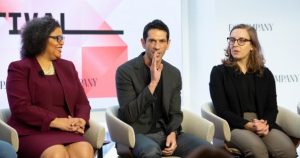— November 19, 2017

geralt / Pixabay
We constantly struggle with innovation and insight, whether it’s for our own organization or our work with customers.
To be honest, I think we make innovation and insight far too complicated.
I don’t know how many “innovation” session I see organizations conducting. Usually, it’s a group of people sitting in a circle. Perhaps they are surrounded by white boards, there are pads of different color “Post-Its.” There may be a facilitator taking the group through a number of “mind-freeing” exercises. Inevitably, they struggle. The groups stare at each other, toss out some ideas, but struggle with really new ideas.
Likewise, we struggle with “how do we provide insights to our customers?” We do research, we assemble groups, we try to discover new perspectives that might catch our customers’ interests. But often we struggle in developing insights.
Part of the problem is our approach to innovating and developing insights.
We do it through some sort of groupthink process, perhaps getting our best sales people together, or getting marketing/product management together to come up with new ideas.
The problem is, we are all prisoners of our own experience.
If our source of ideas is from a group that has the same shared experiences, it’s virtually impossible to come up with something new. Too often, it’s just a repackaging of the same old stuff, perhaps with newer/cooler words, a veneer of technology, or just better graphics. But we really haven’t innovated.
It’s similar with insights, our perspectives are limited by our experience and those of our customers. When we look at similar things over and over, we are blind to those things we don’t look for.
In addition to being prisoners of our own experiences, I think our concept of innovation and insight may limit us. Too often, we think it has to be something “new.” Perhaps, not solving world peace or world hunger, but at least in our domains something brand new.
In reality, I think much innovation and insight doesn’t really have to be new, it just has to be new to us or our customers. Something we’ve never seen or considered before.
If we’re doing our jobs right, if we are researching our customers and their markets, of we are looking at competition, it becomes very difficult for us to see something new. Copying our competitors is not innovation, it’s just following.
So how do we make innovation simpler?
We have to look in different places, we have to source our ideas from areas we’ve never looked at before.
It can be as simple as looking in different places in our own organization. Perhaps, it’s sales and marketing looking at engineering and manufacturing, seeing if there are ideas, methods, and approaches we can learn and adapt to what we do.
Or maybe it’s looking in completely different disciplines or markets.
Some years ago, we ran an innovation workshop with a couple of clients. One client was a giant in sophisticated electronic components, the other was a fashion company, specialized in motorcycle apparel. On one side of the table were a row of people in powder blue shirts and khaki’s, on the other were people in leathers, full sleeves of tattoos, gang colors, and the visible piercings were in very interesting places.
As we started, both groups looked at each other, then they looked at me. The same look was on each person’s face, “WTF???”
After a bit of a rocky start, they really started engaging each other and learning. The electronic components people started seeing things the motorcycle people were doing. While they were old and, perhaps, stale in the motorcycle industry, adapted to electronic components, they were new and innovative. Likewise, the motorcycle people were discovering things the electronic components people were doing, tweaking them to work in their industries and markets.
None of the ideas were new, but they were new to each group. They could be tweaked and adapted to each different industry/market segment.
Likewise, look at wildly different disciplines.
Recently, I was talking to a nephew. He’s getting his PhD in Microbiology from Harvard (says the proud uncle). We started talking about his research, which involves mice, rats, and insects. As we discussed what he was doing, what he was trying to learn, I started seeing some ideas that could be interesting to explore in business. I would never have thought of these, but for that 30 minute discussion at the breakfast table.
Again, the ideas weren’t new, they were just new to me.
As we look at some of the “break through” innovations we read about all the time, for example SaaS, the Cloud, even Smartphones, Uber, AirBnB, much of it is really not new, but artful synthesis of ideas from a variety of other disciplines and markets, packaged in a way that is new and innovative for our markets and customers. For example, the concept of subscription based software is an adaptation from newspapers, magazines, and media. Cloud existed as timesharing decades ago, but has been made more powerful by innovations in networks and software development.
Innovation and insight don’t have to be that difficult. We just have to look in new places, taking ideas and methods, adapting and tweaking them for our markets and customers.
Business & Finance Articles on Business 2 Community
(64)




